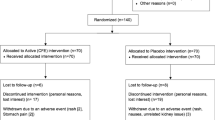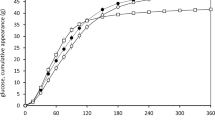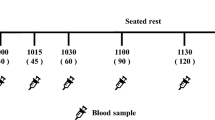Abstract
Objective:
This study examined the acute effects of ingesting a widely used commercial formula containing extracts of bitter orange, green tea and guarana (Gx) on the metabolic rate and substrate utilisation in overweight, adult males at rest (study 1) and during treadmill walking (study 2).
Subjects:
Two different groups of 10 sedentary males with more than 20% body fat participated in studies 1 and 2.
Design:
In each study, subjects participated in two experimental trials during which they were given two 500 mg capsules containing either Gx or a placebo (P) in a counterbalanced double-blind manner. Doses of the main active ingredients were 6 mg of synephrine, 150 mg caffeine and 150 mg catechin polyphenols.
Measurements:
In study 1, subjects completed 7 h supine rest with baseline measures taken during the first hour, with expired gases, blood pressure, heart rate and venous blood being collected every 30 min for the remaining 6 h following ingestion of Gx or P. In study 2, subjects exercised for 60 min at 60% heart rate reserve following ingestion of Gx or P 1 h previously. Venous blood samples were collected twice at rest and at 5, 10, 15, 20, 30, 40, 50 and 60 min, with expired gas measurements taken at 4, 9, 14, 19, 29, 39, 49 and 59 min. In both studies, venous blood was analysed for NEFA, glycerol, glucose and lactate concentrations, while expired gases were used to calculate ATP production from carbohydrate and NEFA, as well as the total substrate utilised.
Results and conclusion:
The results did not show any significant effect of Gx ingestion on total ATP utilisation during 6 h rest or during 60 min treadmill walking. Changes were observed in the relative contributions of CHO and NEFA oxidation to ATP production in both studies, such that there was an increase in ATP production from CHO and a decrease from NEFA. The increase in CHO oxidation was shown to be as high as 30% at rest.
This is a preview of subscription content, access via your institution
Access options
Subscribe to this journal
Receive 12 print issues and online access
$259.00 per year
only $21.58 per issue
Buy this article
- Purchase on Springer Link
- Instant access to full article PDF
Prices may be subject to local taxes which are calculated during checkout





Similar content being viewed by others
References
Ravussin E, Gautier JF . Metabolic predictors of weight gain. Int J Obes Relat Metab Disord 1999; 23: S37–S41.
Spraul M, Ravussin E, Fontvieille AM, Rising R, Larson DE, Anderson EA . Reduced sympathetic nervous system: a potential mechanism predisposing to body weight gain. J Clin Invest 1993; 92: 1730.
Matsumoto T, Miyawaki C, Ue H, Kanda T, Yoshitake Y, Moritani T . Comparison of thermogenic sympathetic response to food intake between obese and non-obese young women. Obesity Research 2001; 9: 78–85.
Matsumoto T, Miyawaki C, Ue H, Yuasa T, Miyatsuji A, Moritani T . Effects of capsaicin-containing yellow curry sauce on sympathetic nervous system activity and diet induced thermogenesis in lean and obese young women. J Nutrit Sci Vitaminol 2000; 46: 309–315.
Shekelle PG, Hardy ML, Morton SC, Maglione M, Mojica WA, Suttorp MJ et al. Efficacy and safety of ephedra and ephedrine for weight loss and athletic performance: a meta-analysis. J Am Med Assoc 2003; 289: 1537–1545.
Preuss HG, DiFerdinando D, Bagchi M, Bagchi D . Citrus aurantium as a thermogenic, weight reduction replacement for ephedra: an overview. J Med 2002; 33: 247–264.
Emorine LJ, Marullo S, Briend-Sutren MM, Patey G, Tate K, Delavier-Klutchko C et al. Molecular characterization of the human beta 3-adrenergic receptor. Science 1989; 245: 1118–1121.
Penzak SR, Jann MW, Cold JA, Hon YY, Desai HD, Gurley BJ . Seville (sour) orange juice: synephrine content and cardiovascular effects in normotensive adults. J Clin Pharmacol 2001; 41: 1059–1063.
Dulloo AG, Seydoux J, Girardier L, Chantre P, Vandermander J . Green tea and thermogenesis: interactions between catechin-polyphenols, caffeine and sympathetic activity. Int J Obes Relat Metab Disord 2000; 24: 252.
Dulloo AG, Geissler CA, Horton T, Collins A, Miller DS . Normal caffeine consumption: influence on daily thermogenesis and daily energy expenditure in lean and postobese human volunteers. Am J Clini Nutri 1989; 49: 44.
Dulloo AG, Duret C, Rohrer D, Girardier L, Mensi N, Fathi M et al. Efficacy of a green tea extract rich in catechin polyphenols and caffeine in increasing 24-h energy expenditure and fat oxidation in humans. Am J Clin Nutri 1999; 70: 1040–1045.
Bell C, Petitt DS, Jones PP, Seals DR . Influence of adiposity on tonic sympathetic support of resting metabolism in healthy adults. Int J Obes Relat Metab Disord 2003; 27: 1315–1318.
Amano M, Kanda T, Ue H, Moritani T . Exercise training and autonomic nervous system activity in obese individuals. Med Sci Sports Exercise 2001; 33: 1287–1291.
Achten JM, Gleeson M, Jeukendrup AE . Determination of the intensity that elicits maximal fat oxidation. Med Sci Sports Exercise 2002; 34: 92.
Smith DA, Dollman J, Withers RT, Brinkman M, Keeves JP, Clark DG . Relationship between maximum aerobic power and resting metabolic rate in young adult women. J Appl Physiol 1997; 82: 156–163.
Durnin JVGA, Womersley J . Body fat assessed from total body density and its estimation from skinfold thickness: measurement on 481 men and women aged 16–72 years. Br J Nutrit 1974; 32: 77.
Draper SB, Wood DM, Fallowfield JL . The VO2 response to exhaustive square wave exercise: influence of exercise intensity and mode. Eur J Appl Physiol 2003; 90: 92.
Sahlin K . High-energy phosphates and muscle energetics. In: Poortmans JR (ed). Principles of Exercise Biochemistry, 3rd rev. edn. Medicine and Sports Science. Basel: Karger, 2004; 46: 87.
Alberty RA . Effect of pH and metal ion concentration on the equilibrium hydrolysis of adenosine triphosphate to adenosine diphosphate. J Biol Chem 1968; 243: 1337.
Koot P, Deurenberg P . Comparison of changes in energy expenditure and body temperatures after caffeine consumption. Annu Nutrit Metab 1995; 39: 135.
Bracco D, Ferrarra JM, Arnaud MJ, Jequier E, Schutz Y . Effects of caffeine on energy metabolism, heart rate, and methylxanthine metabolism in lean and obese women. Am J Physiol 1995; 269: E671.
Acheson KJ, Zahorska-Markiewicz B, Pittet P, Anantharaman K, Jequier E . Caffeine and coffee: their influence on metabolic rate and substrate utilisation in normal weight and obese individuals. Am J Clin Nutr 1980; 33: 987.
Colker CM, Kalman DS, Torina GC, Perlis T, Street C . Effects of citrus aurantium extract, caffeine and St John's Wort on body fat loss, lipid levels and mood states in overweight healthy adults. Curr Ther Res 1999; 60: 145–153.
Engels HJ, Wirth JC, Celik S, Dorsey JL . Influence of caffeine on metabolic and cardiovascular functions during sustained light intensity cycling and at rest. Int J Sports Nutr 1999; 9: 361–370.
Samra JS, Simpson EJ, Clark ML, Forster CD, Humphreys SM, Macdonald IA et al. Effects of epinephrine infusion on adipose tissue: interactions between blood flow and lipid metabolism. Am J Physiol 1996; 271: E834–E839.
Pedersen SB, Bak JF, Holck P, Schmitz O, Richelsen B . Epinephrine stimulates human muscle lipoprotein lipase activity in vivo. Metabolism 1999; 48: 461.
Chasiotis D, Sahlin K, Hultman E . Regulation of glycogenolysis in human muscle in response to epinephrine infusion. J Appl Physiol 1983; 54: 45.
Danforth WH, Helmreich E, Cori CF . The effect of contraction and epinephrine on the phosphorylase content of frog sartorius muscle. Proc Nat Acad Sci USA 1962; 48: 1191.
Kasvinsky PJ, Shechosky S, Fletterick J . Synergistic regulation of phosphorylase a by glucose and caffeine. J Biol Chem 1978; 253: 9102.
Steiner RF, Greer L, Bhat R, Oton J . Structural changes induced in glycogen phosphorylase b by the binding of glucose and caffeine. Biochim Biophys Acta 1980; 611: 269.
Lamont LS, Romito RA, Finkelhor RS, Kalhan SC . β1-adrenoreceptors regulate resting metabolic rate. Med Sci Sports and Exercise 1997; 29: 769.
Welle S, Schwartz RG, Statt M . Reduced metabolic rate during β-adrenergic blockade in humans. Metabolism 1991; 40: 619.
Dupport C, Loeper J, Strosberg AD . Comparitive expression of the human beta(2) and beta(3) adrenergic receptors in Saccharomyces cerevisiae. Biochim Biophys Acta 2003; 1629: 34–43.
Lane JD, Pieper CF, Phillips-Bute BG, Bryant JE, Kuhn CM . Caffeine affects cardiovascular and neuroendocrine activation at work and home. Psychosomat Med 2002; 64: 595–603.
Acknowledgements
Cytodyne Technologies Inc. sponsored this study. We would also like to thank Bev Hale, MSc for research support.
Author information
Authors and Affiliations
Corresponding author
Rights and permissions
About this article
Cite this article
Sale, C., Harris, R., Delves, S. et al. Metabolic and physiological effects of ingesting extracts of bitter orange, green tea and guarana at rest and during treadmill walking in overweight males. Int J Obes 30, 764–773 (2006). https://doi.org/10.1038/sj.ijo.0803209
Received:
Revised:
Accepted:
Published:
Issue Date:
DOI: https://doi.org/10.1038/sj.ijo.0803209
Keywords
This article is cited by
-
Effects of ingesting a pre-workout dietary supplement with and without synephrine for 8 weeks on training adaptations in resistance-trained males
Journal of the International Society of Sports Nutrition (2017)
-
Effects of acute ingestion of a pre-workout dietary supplement with and without p-synephrine on resting energy expenditure, cognitive function and exercise performance
Journal of the International Society of Sports Nutrition (2017)
-
Multiple Dosing of Ephedra-Free Dietary Supplements: Hemodynamic, Electrocardiographic, and Bacterial Contamination Effects
Clinical Pharmacology & Therapeutics (2013)
-
Cardiovascular Toxicity of Citrus aurantium in Exercised Rats
Cardiovascular Toxicology (2013)
-
Blood orange juice inhibits fat accumulation in mice
International Journal of Obesity (2010)



